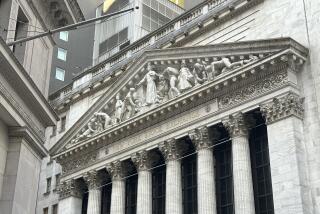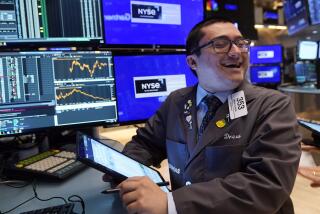Stock-market volatility fades as Dow nudges 13,000
The Dow’s run toward 13,000 may not be the biggest surprise in the stock market this year. The sharp drop in volatility is just as unexpected.
After barely budging last week, the Dow Jones industrial average resumed its effort Monday to permanently vault past past 13,000. It pierced that level briefly last week but has yet to close above it. After overcoming an early-morning sell-off, it’s a smidge over 13,000 at the moment.
The assault on 13,000 has made it easy to overlook the big drop in volatility.
The market was dominated last year by frantic gyrations, with triple-digit moves in the Dow Jones industrial average, both up and down, becoming almost commonplace. This year, by contrast, there have been only three triple-digit days, and all have been to the upside.
That’s certainly a pleasant respite, but the pullback in volatility is unnerving some professional market-watchers. Low volatility suggests investors have become complacent – and in the market’s counter-intuitive ways, that can be a warning sign that stock prices are vulnerable to unexpected bad news.
The most widely used measure of market volatility, the so-called VIX index, has settled comfortably below 20 – roughly where it was before the market fell into a sharp swoon last August. It’s now about 18.
A VIX reading of less than 20 is “the market’s equivalent of a dog sleeping in the sun,” Nicholas Colas, chief market strategist at ConvergEx Group in New York, said in a report to clients.
Colas has several theories to explain the reduced volatility, including that investors have grown ever more confident in the ability of central banks to limit the depth and length of economic shocks.
That may explain why the VIX appears to be simmering down from sudden spikes more quickly these days.
Following the last two market downturns, in early 2010 and mid-2011, the VIX went from an overheated 40 to a placid 20 in slightly more than 100 days, according to Colas. In the previous four times the VIX topped 40, it took an average of 209 days to ease back to less than 20.
The quicker recovery may not mean much. The four earlier spikes above 40 coincided with severe economic or political upheaval – the 1998 Asia crisis, the 2001 terror attacks, the 2002 lead-up to the Iraq war and the 2008 financial crisis. As worrisome as the European debt crisis is, it simply may not stir the same level of investor anxiety.
Still, the temperate VIX reading worries some on Wall Street.
“I’m as happy as anyone that the Dow is so close to 13,000,” Colas wrote. “It’s just that another number – VIX below 20 – worries me more.”
RELATED:
Warren Buffett, in shareholder letter, doubles down on housing
Airline fares rise again, point to higher fuel costs
Dow Jones industrial average closes in on milestone
More to Read
Inside the business of entertainment
The Wide Shot brings you news, analysis and insights on everything from streaming wars to production — and what it all means for the future.
You may occasionally receive promotional content from the Los Angeles Times.










